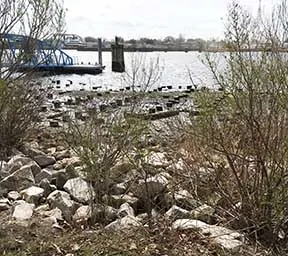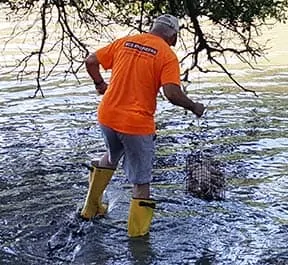

Join SCS Engineers at the 38th Annual Environmental Permitting Summer School (EPSS) in Marco Island, Florida, from July 16th to 19th, 2024. This year’s EPSS promises to be a premier event, uniting public and private professionals for exceptional leadership development, networking, and top-notch programming. The Environmental Permitting Summer School is attended by attorneys, consultants, engineers, state and local government officials, developers, landowners, and others with a strong interest in environmental issues in Florida.
SCS Experts will be speaking on the following topics:
Land and Golf Course Redevelopment: Opportunities and Challenges
Speaker Session:

Remediation Strategies and Case Studies
Speaker Session:

Join us to gain valuable insights and connect with leading professionals in the field. Don’t miss out on this opportunity for growth and collaboration! Click for more conference details and information.
Join SCS Engineers at the 2024 WV Brownfields & Main Street Conference, taking place September 10th to 12th, 2024, at the Summersville Arena & Conference Center. This premier redevelopment event in West Virginia offers insightful sessions and workshops focused on brownfields redevelopment and downtown revitalization in rural communities.
Registration opens in June, so mark your calendars and join us for this all-day event where industry leaders converge to discuss strategies for sustainable development and community renewal. Don’t miss this opportunity to at the 2024 WV Brownfields & Main Street Conference connect, learn, and contribute to the future of West Virginia’s economic and environmental landscape.
Melissa Schick will be speaking at the conference!
Join SCS Engineers at the 2024 Virginia Brownfields Conference, an event hosted by the Virginia Department of Environmental Quality (DEQ) and the City of Lynchburg Office of Economic Development & Tourism. This conference, held in Lynchburg, VA from June 25th to June 27th, offers a comprehensive exploration of brownfield redevelopment and the revitalization of communities.
Attendees will have the opportunity to immerse themselves in the captivating story of Lynchburg’s development, including the remarkable transformation of landmarks such as Jefferson Street and The Virginian Hotel. Through engaging sessions, participants will gain valuable insights into the various facets of brownfield redevelopment, from initial concept planning to the final stages of development and reuse.
Melissa Schick will be presenting on Numbers Talk! Elevating Communities Through Data and Funding
Join SCS Engineers and fellow attendees for three days of learning, networking, and exploration at the 2024 Virginia Brownfields Conference. Don’t miss your chance to be part of this dynamic event shaping the future of brownfield redevelopment in Virginia and beyond.
Join SCS Engineers at The 2024 Florida Brownfields Association (FBA) Annual Brownfields Conference June 26th-28th. Working in cooperation with a wide range of governmental and non-governmental organizations and citizen groups, are a group of environmental stakeholders and professionals who provide brownfields information, assistance, and redevelopment strategies to communities and the public. The 2024 FBA Annual Brownfields Conference brings stakeholders together for networking, learning, and a community day for local organizations to help support and strengthen environmental justice support. The conference is June 26th – 28th in Gainesville, FL.
Melissa Schick and Douglas Latulippe will be in attendance. Register today!
Douglas will be presenting Solar on Brownfields at the conference. Don’t miss it!
Meet SCS Engineers brownfields experts, Candy Elliott, PG, and Melissa Schick, at our Booth at the Southeast Brownfields Conference and EPA New Grantee Workshop, September 21-22, in Pelham, Alabama.


Alabama Brownfields Association (ALBFA ) is hosting this annual event which includes a one-day technical conference plus EPA Region IV holding its New Grantee Workshop across two half-days. The conference is a forum for environmental professionals, state environmental agencies, tribes, local governments, and community stakeholders interested in brownfield redevelopment. Event registrants are able to attend a reception held on the evening of the 21st.
Click for more conference details and registration information
We hope to see you there!
Join SCS on June 10 for another client webinar. Using case studies, we show you how our clients tackle common challenges using proven GIS technology to reduce expenses and run more productively.
Property Development: Time is money on development projects. Environmental engineers use GIS to more accurately pinpoint potential contamination sources, conduct site assessments, strategize remediation solutions, and see sampling results weeks faster. Infographics and dashboards show if and exactly where to continue sampling without waiting weeks or months for reports.
Landfills: Operators make diagnostic and forensic use of GIS to address maintenance tasks faster. We’ll cover modeling 3D wells and liquid level data, showing how GIS embedded dashboards and infographics pinpoint exactly where to assign staff. At the same time, supervisors monitor completed assignments seeing real-time results and what still needs attention.
Siting Solid Waste Facilities: Decision-makers use multi-criteria decision analysis incorporated into a geographic information system to account for relevant technical data, environmental, social, and economic factors during the site selection of a waste transfer station. The resulting maps and infographics are useful at public meetings too.
Thanks to South Florida’s hot real estate market and impressive growth rates, a dwindling supply of properties are available for development in the area. The Atlantic Ocean limits South Florida’s development options to the east and Florida Everglades to the west. Due to these supply limitations, developers seek to redevelop contaminated landfills, golf courses, and agricultural land. Environmental due diligence is essential to the successful redevelopment of these types of properties. Depending on the property’s size and the extent of the contamination, redeveloping contaminated properties can cost upwards of a million dollars.
Typically, developers will have to deal with contaminants like ammonia at a landfill redevelopment project, arsenic at a golf course redevelopment project, or pesticides at agricultural redevelopment projects. In some cases, remediation and assessment using the standard or “default” cleanup target level (CTL) can stop a project from proceeding. However, before abandoning the project, developers should consider the potential for establishing alternative cleanup target levels (ACTLs) for the site’s contaminants.
Several technical strategies are available to developers considering redeveloping contaminated properties to reduce overall costs and expedite the construction schedule. Costs associated with managing material above a default CTL can include disposal of contaminated material, importing clean fill, and delays to permitting and construction schedules if an environmental regulator determines your assessment is incomplete.
Understanding Default Cleanup Target Levels
Environmental regulators use a range of tools to develop default CTLs. Default CTLs can be based on complex equations that consider toxicity and exposure assumptions such as ingestion rates, body weight, age, and exposure levels. Soil properties are also considered. In some cases, human health may not even be the determining factor in calculating a default CTL. Rather, a particular contaminant’s environmental impact on the local ecosystem may be what determines its default CTL.
While default CTLs are useful tools to formulate remediation strategies on a broad range of sites, default CTL values will be overly conservative for other sites. More explicitly, some sites’ present and future use and exposure characteristics are so different from the assumptions used to calculate the default CTLs – that the default CTL does not accurately correspond to the risk associated with the proposed sites’ use. In such cases, explore the development of an alternative cleanup target level (ACTL).
Establishing Alternative Cleanup Target Levels
With the right approach, a site ACTL could provide significant cost savings while maintaining regulatory compliance. But buyers beware; choose your environmental consultant carefully. The consultant should understand the site-specific factors that affect the calculation of the ACTLs. Often, a knowledgeable consultant has a good idea of the outcome even before investing the client’s time and money pursuing the alternative.
Cost and Schedule Benefits
To illustrate cost and development time-savings, consider a simple example of arsenic-contaminated soil at a residential development. Suppose there are no other reuse options available for the contaminated material, and the material must be disposed of at a landfill. Given 100,000 cubic yards (cy) of contaminated material at a disposal cost of $60 per cy, we estimate 6 million dollars in disposal costs, not including importing clean fill. However, if the site is an age-restricted residential community, certain exposure assumptions could be modified to calculate a much higher ACTL for arsenic. The soil would no longer be regulated as contaminated, and costs associated with disposal, imported material, and soil tracking are eliminated. Soil that was considered contaminated based on the default CTL is now clean based on the ACTL.
Let us look at a more complex example. Consider the case of a site contaminated with dieldrin, a common pesticide found at golf courses and agricultural properties. A leachability ACTL recalculates the default leachability of a particular soil contaminant. A leachability ACTL uses site-specific soil chemical and physical properties, such as soil organic matter content, bulk density, and annual average soil moisture content, and determines a more realistic risk profile associated with soil that could potentially leach contaminants into the groundwater. With an ACTL above the default CTL, remediation may not be necessary, or the site may not require a deed restriction, or ongoing costs associated with monitoring of the groundwater or operation of a remediation system could be eliminated, making the completed project more attractive to potential buyers.
Summary
Developing ACTLs is a careful, thoughtful strategy that an experienced environmental consultant can propose based on the site’s unique conditions. The developer’s financial objectives and schedule and the property end-use must be carefully considered to develop a thorough redevelopment approach. The use of an ASCTL could mean the difference between a project that is financially infeasible and one that is attractive and profitable.
Learn more about remediation and brownfields redevelopment.

Solar Ready CCR Site Closures Help Energy Companies Move Toward a Sustainable Future
Electricity is the one big energy source that can be free of carbon emissions. You can make it from the sun. You can make it from the wind. Tap the heat of the Earth, hydropower. While all utilities are moving in a sustainable, environmentally friendly direction, Aliant Energy stands out for making progress and keeping rates reasonable for consumers.
At the recent USWAG Workshop on Decommissioning, Repurposing & Expansion of Utility Assets held October 2019, Eric Nelson presented on the opportunities for solar generation at closed CCR sites and provided an overview of civil and geotechnical considerations when redeveloping closed sites as solar generating assets. His presentation demonstrated these considerations through the use of a case study.
SCS Engineers has assisted Alliant Energy with the design and/or construction of multiple coal combustion residual (CCR) surface impoundment closures. Two of the completed closures are the former Rock River Generating Station in Beloit, Wisconsin, and the M.L. Kapp Generating Station in Clinton, Iowa.
Both sites were closed by incorporating Alliant Energy’s vision to create “solar ready” sites. The Rock River site is now home to just over 2 megawatts (MW) of solar photovoltaic (PV) generating capacity, which was developed on the footprint of the now-closed on-site landfill and ash ponds. Although no solar assets have been developed at the site, the M.L. Kapp ash pond closure represents another opportunity for Alliant Energy to repurpose a closed ash pond for clean power.
Two additional closure designs are in process that incorporates similar elements, making them available for future solar generating asset development.
For more information visit SCS Engineers

Even the simplest impoundment closures come with design challenges. It is a challenge to navigate project constraints, whether technical, regulatory, or financial, to design and implement an effective closure strategy. Cost often helps to determine the “balance” between project constraints when the future end use of a closed CCR surface impoundment or the property it occupies is undefined. When a post-closure end use is defined, finding balance among project constraints to best serve that future use provides rewarding challenges.
SCS Engineers has navigated this balancing act on impoundment closure projects during generating facility decommissioning. Through a presentation of case studies, you can learn how this team has approached ash pond closure planning and execution where the future use of the impoundment site ranged from undefined to the home of a new solar photovoltaic installation. Examples also include potential future industrial use or property sale.
Case studies will highlight how geotechnical, hydrological, regulatory, or simple physical constraints have influenced the design and implementation of CCR surface impoundment closures.
EUEC 2019 in San Diego, February 25-27, 2019. Conference details here.
Creosote is a toxic chemical that has been commonly used as a wood preservative for over 50 years. It acts as a pesticide, herbicide, and fungicide and has been used widely in both land and marine applications.

Studies have indicated that pilings and other artificial structures provide possible environmental benefits, such as habitat for invertebrates, roosts for birds, and a spawning location for certain fish species (e.g., herring). However, far more studies have indicated potential harm from treated structures. It is documented that pilings will leach the most during the first two years after installation after which leaching declines significantly.
The Norfolk Riverfront area has been developed since at least 1887, and the use of treated pilings can be presumed. The majorities of the pilings are presumed to
have been installed over two years ago and are therefore beyond the 2-year timeframe for significant leaching. Pilings that are shown to be in good condition and with a viable use as part of the development effort can remain in place with little effect on the surrounding environment.
This paper discusses the City of Norfolk’s waterfront brownfield redevelopment and the importance of understanding and developing an approach for the managed disposal of creosote pilings. The guidance is based on strategies approved by the U.S. Environmental Protection Agency and other noted expert sources such as waterfront municipalities, published white papers, and peer-reviewed publications.
Take me to the paper and information about the authors.

Other environmental groups are hard at work in the region. Lynnhaven River NOW, is one organization working with residents, businesses, and community leaders who are restoring and protecting Virginia Beach waterways.
Learn more here: http://www.lynnhavenrivernow.org/